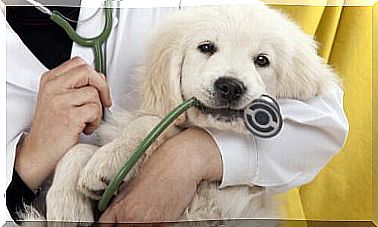When Are Drugs Toxic To Dogs?

If there is one thing we will never advise an owner to do, it is to administer non-prescription medications to their dog. In fact, in case of suspicion or evidence of a health problem, going to the vet is the only option. This is because some medications can be toxic to dogs, especially those intended for humans.
Although humans are also mammals and our bodies function in a similar way to that of our pets, dogs and people are different, and the side effects a drug can cause vary greatly from one species to another. Let’s see when drugs are toxic to dogs.
Toxic drugs for dogs: anti-inflammatories
Ibuprofen, aspirin and paracetamol are the most frequently used drugs. They are used to reduce the effects of mild or moderate pain. Paracetamol is also antipyretic, meaning it reduces fever.
We usually take them when we have a mild condition, such as headaches, body aches or the flu. Unfortunately, these drugs are also the ones that are abused the most.
In fact, due to their recurring use and the ease with which we obtain them, it is easy to think that they can also be the solution for the discomfort of pets. However, they are very dangerous when fed to animals. To be sure, they can have lethal effects on dogs.

The lethal dose in dogs
The therapeutic amount of paracetamol that a dog could take is very low, about 15 mg / kg compared to humans, and the lethal dose, 150 mg / kg is also low considering that the tablets for humans are marketed in units of 500. mg to 1 g of product, well above the lethal dose in dogs.
This means that if we gave a ten-pound dog one of these pills, we would have exceeded the lethal dose more than five times. The animal would probably die before getting to the vet.
How do drugs work in the body?
How quickly the first symptoms appear depends on how long it takes for drugs to circulate through the bloodstream to the target organ. Normally, the drug circulates in the blood until it is metabolized in the liver and filtered in the kidneys. The time taken by these organs to metabolize it depends, among other factors, on the concentration of the product.
The drug metabolism rate is not the same in all dogs. In some, the metabolism can be so rapid that toxic blood levels cannot be reached. In others, however, it can be very slow, so lower or normal doses can have toxic effects.
Drug interactions with other drugs with which the animal must be treated, its genetics, or whether it has any type of disease, are the main factors affecting the rate of drug metabolism.

Toxic Drugs in Dogs: What Are the Symptoms?
Some common symptoms produced by toxic drugs in dogs are:
- Anorexia or lack of appetite.
- He retched.
- Abdominal pain.
- Lethargy.
- Dehydration.
- Jaundice. The skin and mucous membranes appear yellow in color due to the malfunction of the liver.
- Swelling of the paws.
- Bruises. It mostly happens with aspirin.
- Temperature increase. Typical symptom of aspirin consumption.
- Cyanosis. Some parts of the animal’s body take on a bluish color due to a lack of blood oxygenation.
- Shortness of breath or wheezing. Some drugs that are toxic to dogs prevent tissue oxygenation when they come into contact with proteins in the blood.
- Tachycardia.
- Coma.
- Death from liver and kidney failure.
Toxic drugs for dogs also damage the gastrointestinal mucosa, as they inhibit prostanglandins, molecules responsible for protecting the intestine by means of a mucus that lubricates its surface and reduces gastric acid secretion.
In addition to the toxic effects of these drugs in dogs, the original problem the dog had may be aggravated by taking the drug, making veterinary diagnosis difficult. For all these reasons, the only thing to give in these cases is to go to a specialized center as soon as possible.









